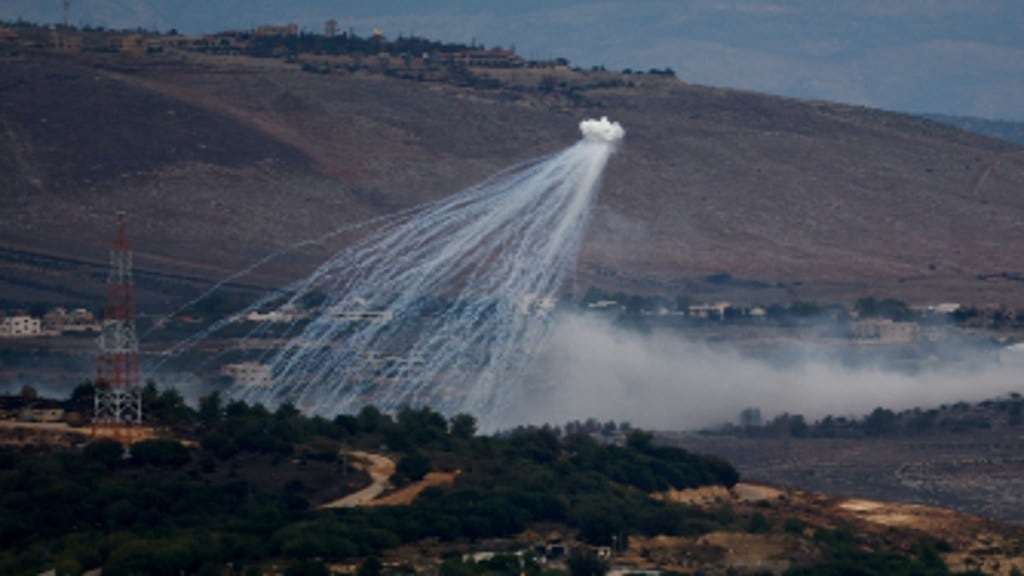White phosphorus is a highly reactive substance that ignites when exposed to oxygen, producing intense heat and thick smoke. This article explores what white phosphorus is, its military uses, and the legal and humanitarian concerns surrounding its use by Israeli forces.
What is White Phosphorus?
White phosphorus is a pyrophoric chemical that spontaneously ignites in air, reaching temperatures of up to 815 degrees Celsius. It produces a distinctive garlic-like odour and is classified under “Pyrophoric solids, category 1” in the Globally Harmonized System of Classification and Labelling of Chemicals. This classification includes chemicals that catch fire almost immediately when exposed to air.
Military Uses of White Phosphorus
White phosphorus is primarily used in military operations for creating smokescreens. It is dispersed via artillery shells, bombs, and rockets to obscure troop movements and protect forces from guided missiles by interfering with infrared optics and tracking systems. These munitions can either burst on the ground for concentrated smoke or explode in the air to cover a larger area. Additionally, white phosphorus can be used as an incendiary weapon to cause fires, disrupt enemy positions, and damage infrastructure.
Harmful Effects of White Phosphorus
Exposure to white phosphorus is extremely dangerous. It can cause severe second- and third-degree burns, often penetrating down to the bone. These burns are notoriously painful, difficult to heal, and prone to infection. Particles that remain in the body can reignite if exposed to air. Inhaling white phosphorus smoke can lead to serious respiratory damage and internal organ harm. Survivors of white phosphorus injuries often face lifelong pain, impaired mobility, and disfigurement.
White phosphorus is not only harmful to individuals but also to the environment. Fires started by white phosphorus can spread rapidly, especially in windy conditions, destroying crops, killing livestock, and causing extensive property damage.
International Law and White Phosphorus
Under international humanitarian law, the use of white phosphorus in areas with dense civilian populations is prohibited due to its indiscriminate and devastating effects. The United Nations Convention on Certain Conventional Weapons (CCW), specifically Protocol III, regulates the use of incendiary weapons like white phosphorus. While the protocol bans air-delivered incendiary weapons in civilian areas, it allows the use of such weapons for purposes like creating smokescreens in open fields.
However, this protocol has significant loopholes. It does not completely ban the use of ground-launched incendiary weapons in civilian areas, and it excludes multipurpose munitions like those containing white phosphorus, which are primarily considered to be for creating smoke rather than causing burns. Israel is not a party to Protocol III, whereas Lebanon is.
Israel’s Use of White Phosphorus
According to Human Rights Watch (HRW), Israeli forces have used white phosphorus bombs in at least 17 municipalities across southern Lebanon since October last year. The use of airburst white phosphorus in populated areas is considered unlawfully indiscriminate under international humanitarian law. Israel has a history of using white phosphorus; during Operation Cast Lead in Gaza from December 2008 to January 2009, HRW documented Israel’s use of white phosphorus in densely populated areas, violating the laws of war.
The use of white phosphorus by Israel raises serious humanitarian concerns. Inhalation of its smoke can cause severe lung injuries and suffocation, and the resulting fires can devastate large areas, continuing to burn until the phosphorus is completely consumed. Treatment of white phosphorus injuries is complex and requires special training to protect medical personnel from contamination.
Historical Context
White phosphorus munitions have been used in various conflicts since the late 19th century, from the Irish nationalist struggles to World War I and II, the US invasion of Iraq in 2004, and the Nagorno-Karabakh conflict. Recently, Russia was accused of using white phosphorus during its invasion of Ukraine.

